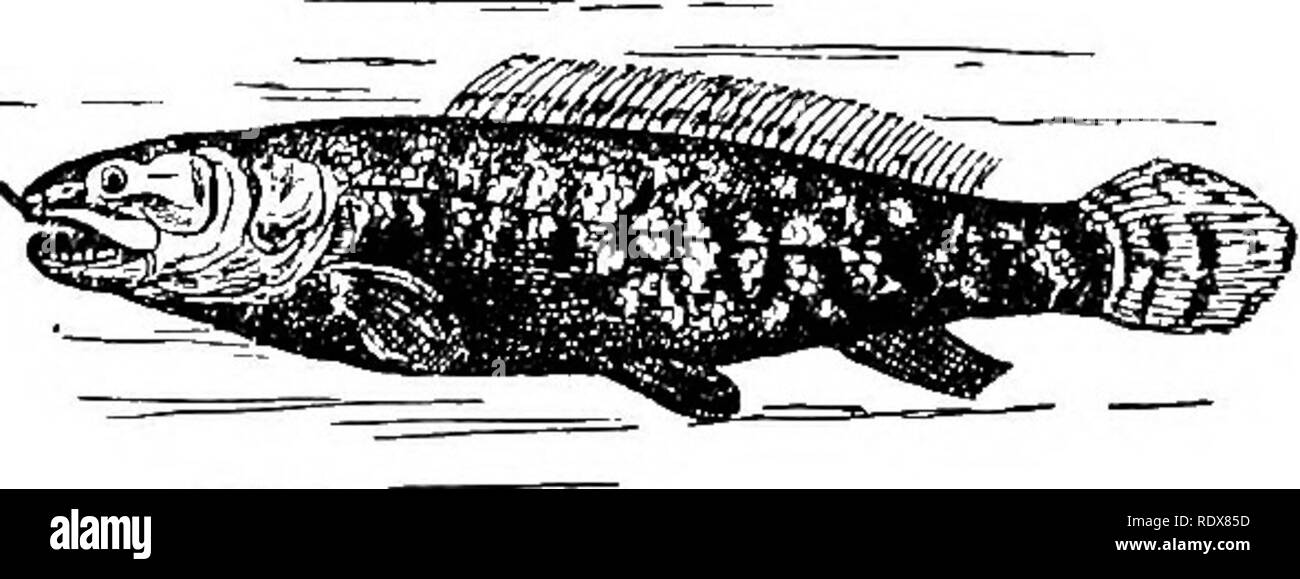. Natural history. Zoology. 510 PISCES—SUB-CLASS III. — TELEOSTOMI. heterocercal type. In the skeleton, the vertebrae are unique among living fishes in that the articular surfaces of their bodies form a cup behind and a ball in front. The air-bladder has a duct, and the nerves supplying the eyes where they meet one another in the middle line give off interlacing fibres, and there are remnants of a spiral valve in the lining membrane of the intestine. Bony pike, which are abundant in many of the North American rivers, are very analogous in their habits to true pike, feeding upon other fishes. S

Image details
Contributor:
The Book Worm / Alamy Stock PhotoImage ID:
RDX85DFile size:
7.2 MB (270.7 KB Compressed download)Releases:
Model - no | Property - noDo I need a release?Dimensions:
2577 x 970 px | 21.8 x 8.2 cm | 8.6 x 3.2 inches | 300dpiMore information:
This image is a public domain image, which means either that copyright has expired in the image or the copyright holder has waived their copyright. Alamy charges you a fee for access to the high resolution copy of the image.
This image could have imperfections as it’s either historical or reportage.
. Natural history. Zoology. 510 PISCES—SUB-CLASS III. — TELEOSTOMI. heterocercal type. In the skeleton, the vertebrae are unique among living fishes in that the articular surfaces of their bodies form a cup behind and a ball in front. The air-bladder has a duct, and the nerves supplying the eyes where they meet one another in the middle line give off interlacing fibres, and there are remnants of a spiral valve in the lining membrane of the intestine. Bony pike, which are abundant in many of the North American rivers, are very analogous in their habits to true pike, feeding upon other fishes. SUB-ORDER VII.—PROTOSPONDYLI. The single existing family {Amiidce) of this once abundant subordinal group is now represented by the bow-fin (Amia-calva) of the fresh waters of the United_ States. This fish, while agreeing with the bony pike in the con- formation of the optic nerves supplying the eyes, differs in the fuller develop- ment of the spiral valve in the intestine, and in the simpler form of the bodies of the vertebrae, which are disc-like. Although the scales are coated with ganoin, they differ from those of the bony pike in being thin, rounded, and deeply over-lapping. A peculiar feature of the bow-fin, and the one from which it takes its vernacular name, is the great length of the dorsal fin, which occupies more than half the entire length of the back, and posteriorly is separated only by a notch from the tail-fin ; the latter Fig. 33—Bow-fin. being of the abbreviate heterocercal type. The bow-fin grows to a length of about a couple of feet, and is a carnivorous fish, exceedingly abundant in some of the North American lakes. It feeds not only on other fishes, but likewise on various invertebrate animals, and can exist for a considerable time out of water. Its favourite haunts are the dense masses of floating vegetation fringing the North American lakes, among which it lays during the month of May a host of minute eggs. SUB-ORDER VIII.—CHONDROSTEI—STURGEON